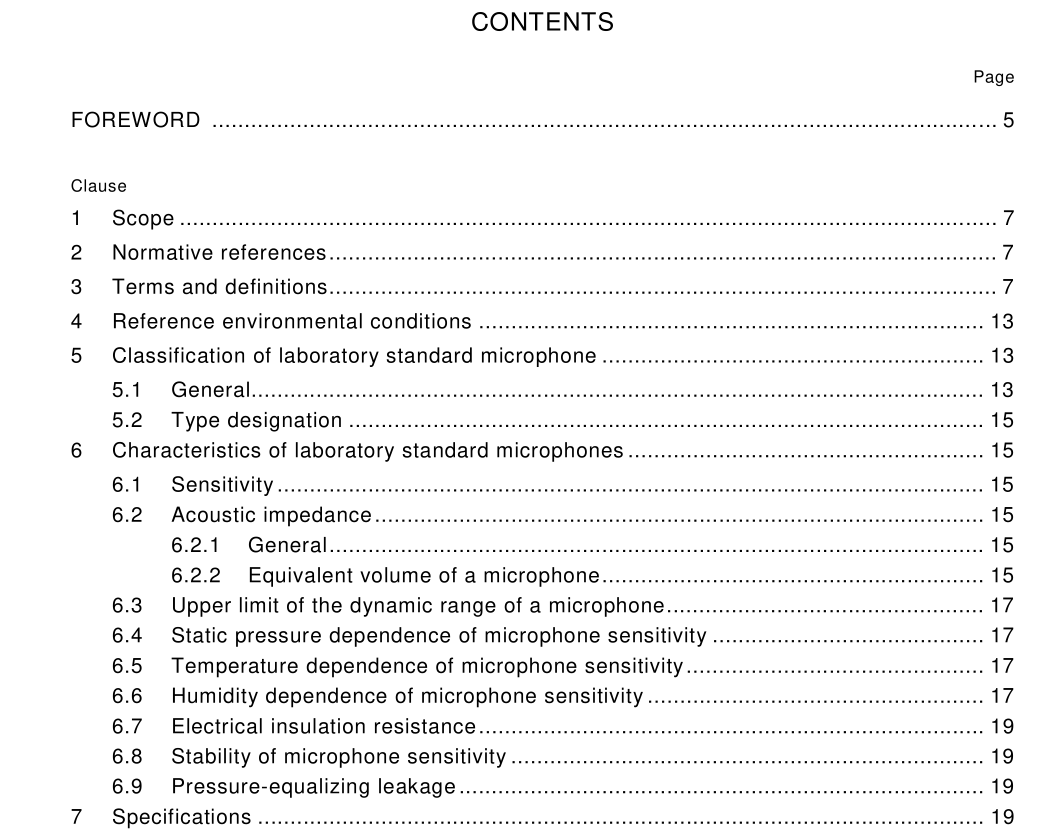IEC 61094-1 pdf download

IEC 61094-1 pdf download.Measurement microphones
1 Scope
This part of IEC 61 094 specifies mechanical dimensions and certain electroacoustic characteristics for condenser microphones used as laboratory standards for the realization of the unit of sound pressure and for sound pressure measurements of the highest attainable accuracy. The specifications are intended to ensure that primary calibration by the reciprocity method can be readily carried out. This part also establishes a system for classifying laboratory standard condenser micro- phones into a number of types according to their dimensions and properties in order to facilitate the specification of calibration methods, the conducting of inter-laboratory comparisons involving the calibration of the same microphones in different laboratories, and the interchangeability of microphones in a given calibration system.
2 Normative references
The following normative documents contain provisions which, through reference in this text, constitute provisions of this part of IEC 61 094. For dated references, subsequent amendments to, or revisions of, any of these publications do not apply. However parties to agreements based on this part of IEC 61 094 are encouraged to investigate the possibility of applying the most recent editions of the normative documents indicated below. For undated references, the latest edition of the normative document referred to applies. Members of ISO and IEC maintain registers of currently valid International Standards. IEC 60050(801 ):1 994, International Electrotechnical Vocabulary (IEV) – Chapter 801 : Acoustics and electroacoustics ASME B1 .1 :1 989, Unified inch screw threads (UN and UNR thread form)
3 Terms and definitions
For the purposes of this part of IEC 61 094, the following definitions apply. Remark – The underlined symbols are complex quantities. 3.1 condenser microphones microphone that operates by variation of electrical capacitance [IEV 801 -26-1 3]. NOTE Only condenser microphones operating by a virtually constant charge obtained from an external polarizing voltage applied from a source of suitably high internal resistance are considered.
3.2 laboratory standard microphone condenser microphone capable of being calibrated to a very high accuracy by a primary method such as the closed coupler reciprocity method, and meeting certain severe requirements on mechanical dimensions and electroacoustical characteristics, especially with respect to stability in time and dependence on environmental conditions 3.3 open-circuit voltage alternating voltage appearing at the electrical output terminals of a microphone as measured by the insert voltage technique when the microphone is attached to the ground shield configuration specified in 7.2 but is otherwise unloaded Unit: volt, V NOTE Owing to the capacitive nature of the microphone, the voltage at the electrical terminals depends on the electrical load presented by the mechanical and electrical attachment of the microphone to a preamplifier. For this reason, preamplifiers used for measuring the open-circuit voltage of a microphone should fulfill the requirements of 7.2. 3.4 pressure sensitivity of a microphone for a sinusoidal signal of given frequency and for given environmental conditions, the quotient of the open-circuit voltage of the microphone by the sound pressure acting over the exposed surface of the diaphragm (i.e. at the acoustical terminals of the microphone), the sound pressure being uniformly applied over the surface of the diaphragm. This quotient is a complex quantity, but when phase information is of no interest the pressure sensitivity may denote its modulus only Unit: volt per pascal, V/Pa 3.5 pressure sensitivity level of a microphone logarithm of the ratio of the modulus of the pressure sensitivity | M p | to a reference sensitivity. The pressure sensitivity level in decibels is 20 lg (| M p | / M r ), where the reference sensitivity M r is 1 V/Pa Unit: decibel, dB3.6 free-field sensitivity of a microphone for a sinusoidal plane progressive sound wave of given frequency, for a specified direction of incidence, and for given environmental conditions, the quotient of the open-circuit voltage of the microphone by the sound pressure that would exist at the position of the acoustic centre of the microphone in the absence of the microphone. This quotient is a complex quantity, but when phase information is of no interest, the free-field sensitivity may denote its modulus only Unit: volt per pascal, V/Pa NOTE 1 At frequencies sufficiently low for the disturbance of the sound field by the microphone to be negligible, the free-field sensitivity approaches the pressure sensitivity (see 6.9 for practical limitations). NOTE 2 The position of the acoustic centre is a function of frequency. 3.7 free-field sensitivity level of a microphone logarithm of the ratio of the modulus of the free-field sensitivity | M f | to a reference sensitivity. The free-field sensitivity level in decibels is 20 lg (| M f | / M r ), where the reference sensitivity M r is 1 V/Pa Unit: decibel, dB









